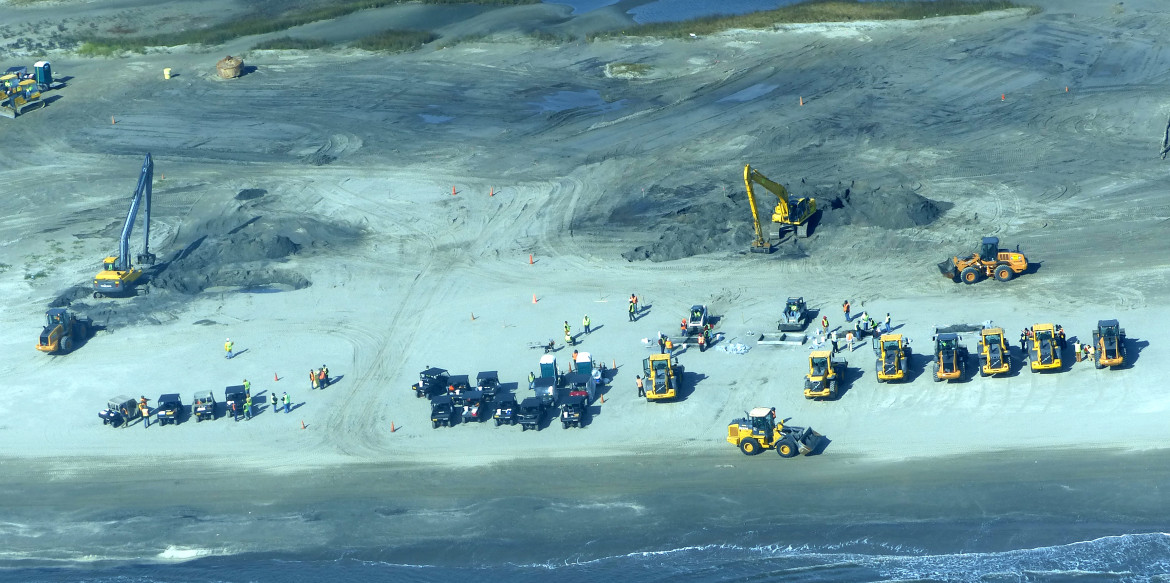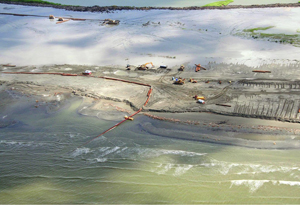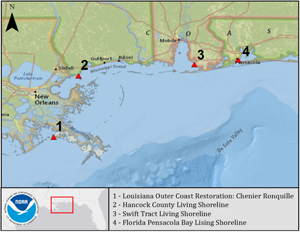http://www.whistleblower.org/program-areas/public-health/corexit
On April 19, 2013, GAP released Deadly Dispersants in the Gulf: Are Public Health and Environmental Tragedies the New Norm for Oil Spill Cleanups? The report details the devastating long-term effects on human health and the Gulf of Mexico ecosystem stemming from BP and the federal government’s widespread use of the dispersant Corexit, in response to the 2010 Deepwater Horizon oil spill.
GAP teamed up with the nonprofit Louisiana Environmental Action Network (LEAN) to launch this effort in August 2011 after repeatedly hearing from Gulf residents and cleanup workers that official statements from representatives of BP and the federal government were false and misleading in the wake of the Deepwater Horizon disaster. Over the next 20 months, GAP collected data and evidence from over two dozen employee and citizen whistleblowers who experienced the cleanup’s effects firsthand, and GAP studied data from extensive Freedom of Information Act (FOIA) requests. Taken together, the documents and the witnesses’ testimony belie repeated corporate and government rhetoric that Corexit is not dangerous. Worse than this, evidence suggests that the cleanup effort has been more destructive to human health and the environment than the spill itself.
Conclusions from the report strongly suggest that the dispersant Corexit was widely applied in the aftermath of the Deepwater Horizon explosion because it caused the false impression that the oil disappeared. In reality, the oil/Corexit mixture became less visible, yet much more toxic than the oil alone. Nonetheless, indications are that both BP and the government were pleased with what Corexit accomplished.
The report is available here:
Part One, Corexit_Report_Part1_041913
Part Two, part2
Part Three _part3
You can download an Executive Summary of the report here.Executive_Summary_Corexit
Additional report exhibits are on file with GAP.
To produce the report, GAP investigators interviewed 25 whistleblowers who provided firsthand accounts of Corexit’s impact. While many chose to remain anonymous – including government officials – 16 whistleblowers provided full affidavits about their experiences, made publicly available in the report (excerpts from these affidavits can be found below).
Witnesses interviewed include cleanup workers, professionals (doctors, industry leaders), divers contracted by the federal government, and Gulf residents. The interviewees represent different geographic areas and are diverse in terms of age and gender. LEAN was instrumental in supporting this investigation. Further, one of GAP’s key whistleblowers, Dr. Wilma Subra, is a technical advisor for LEAN/Louisiana Mississippi Riverkeeper.
GAP has also teamed up with TakePart to tell the EPA: Ban Corexit! Sign our petition today!
Read the joint letter that LEAN, GAP and Gulf partners sent to the federal government, calling on various agencies to address the health crisis in the Gulf.
Read the in-depth Newsweek/The Daily Beast story on GAP’s report here.
Read the TakePart coverage here.
Read the New Orleans Times-Picayune coverage here.
Read the Mother Jones coverage here.
Watch the Al Jazeera coverage here.
Select Report Findings
Existing Health Problems
Eventually coined “BP Syndrome” or “Gulf Coast Syndrome,” all GAP witnesses experienced spill-related health problems. Some of these effects include: blood in urine; heart palpitations; kidney damage; liver damage; migraines; multiple chemical sensitivity; neurological damage resulting in memory loss; rapid weight loss; respiratory system and nervous system damage; seizures; skin irritation, burning and lesions; and temporary paralysis.
Interviewees are also extremely concerned about recognized long-term health effects from chemical exposure (from those specific chemicals found in Corexit/oil mixtures), which may not have manifested yet. These include reproductive damage (such as genetic mutations), endocrine disruption, and cancer.
Blood test results from a majority of GAP interviewees showed alarmingly high levels of chemical exposure – to Corexit and oil – that correlated with experienced health effects. These chemicals include known carcinogens.
The Failure to Protect Cleanup Workers
Contrary to warnings in BP’s own internal manual, BP and the government misrepresented known risks by asserting that Corexit was low in toxicity.
Despite the fact that the Occupational Safety and Health Administration has developed a highly-lauded safety training program for cleanup workers, the workers interviewed reported that they either did not receive any training or did not receive the federally required training.
Federally required worker resource manuals detailing Corexit health hazards (according to a confidential whistleblower) were not delivered or were removed from BP worksites early in the cleanup, as health problems began.
A FOIA request found that government agency regulations prohibited diving during the spill due to health risks. Yet, divers contracted by National Oceanic and Atmospheric Administration and interviewed by GAP dove after assurances that it was safe and additional protective equipment was unnecessary.
BP and the federal government, through their own medical monitoring programs, each publicly denied that any significant chemical exposure to humans was occurring. Of the workers GAP interviewed, 87% reported contact with Corexit while on the job and blood test results revealed high levels of chemical exposure.
BP and the federal government believed that allowing workers to wear respirators would not create a positive public image. The federal government permitted BP’s retaliation against workers who insisted on wearing this protection. Nearly half of the cleanup workers interviewed by GAP reported that they were threatened with termination when they tried to wear respirators or additional safety equipment on the job. Many received early termination notices after raising safety concerns on the job.
All workers interviewed reported that they were provided minimal or no personal protective equipment on the job.
Ecological Problems & Food Safety Issues
A majority of GAP witnesses reported that they found evidence of oil or oil debris after BP and the Coast Guard announced that cleanup operations were complete.
BP and the federal government reported that Corexit was last used in July 2010. A majority of GAP witnesses cited indications that Corexit was used after that time.
The oil-Corexit mixture coated the Gulf seafloor and permeated the Gulf’s rich ecological web. GAP witnesses have revealed underwater footage of an oil-covered barren seafloor, documenting widespread damage to coral reefs.
The FDA grossly misrepresented the results of its analysis of Gulf seafood safety. Of GAP’s witnesses, a majority expressed concern over the quality of government seafood testing, and reported seeing new seafood deformities firsthand. A majority of fishermen reported that their catch has decreased significantly since the spill.
Inadequate Compensation
BP’s Gulf Coast Claims Fund (GCCF) denied all health claims during its 18 months of existence. Although a significant precedent, the subsequent medical class action suit excluded countless sick individuals, bypassed the worst health effects resulting from exposure to dispersant and oil, offered grossly inadequate maximum awards compared to medical costs, and did not include medical treatment.
Recommendations
The BP spill was the worst environmental disaster in American history, but the government’s consent to BP’s use of Corexit has caused long-term human and ecological tragedies that may be worse than the original spill. As deepwater drilling expands off U.S. coasts, it is inevitable that other incidents will occur. Renewed reliance on Corexit is planned for future oil spills, and BP has declared it will continue to use the deadly dispersant as long as the government permits doing so.
GAP’s report illustrates that both BP and the government must take corrective action to mitigate ongoing suffering and to prevent the future use of this toxic substance. The report makes recommendations for:
A federal ban on the use of Corexit, which is already banned in the United Kingdom (BP’s home country) and Sweden.
Congressional hearings on the link between the current public health crisis in the Gulf and Corexit exposure.
The immediate reform of EPA dispersant policy, specifically requiring the agency to determine whether such products are safe for humans and the environment prior to granting approval under the National Contingency Plan (NCP).
The establishment of effective medical treatment programs – by medical experts specializing in chemical exposure – for Gulf residents and workers.
The federal government’s funding of third-party, independent assessments of both the spill’s health impact on Gulf residents and workers, and such treatment programs when established.
Early, preliminary finding of this GAP investigation was reported in April 2012 by a cover story in The Nation magazine. On April 19, 2013, on the eve of the third anniversary of the Deepwater Horizon disaster, noted journalist Mark Hertsgaard published many of the full report’s findings in Newsweek/The Daily Beast.
Select Excerpts from Whistleblower Affidavits & Report Statements
As an environmental scientist, I look at the way the government and BP are handling, describing and discussing the spill … [T]he government did not account for the increased toxicity of the combined oil and Corexit.
– Scott Porter, Diver, Marine Biologist
[W]hen a BP representative came up on the speedboat and asked if we need anything, I again explained my concerns about breathing in the Corexit and asked him for a respirator … He explained ‘If you wear a respirator, it is bringing attention to yourself because no one else is wearing respirators, and you can get fired for that.’
– Jorey Danos, Cleanup Worker
What brought all of these individuals into the same pool was the fact that their symptoms were almost identical, and were different from anything that I had ever observed in my 40 plus years as a physician … However, until people are educated about the symptoms associated with exposure to toxic waste from the spill, we cannot assume they will make the connection. I continue to witness this disconnect and these symptoms on a daily basis.
– Dr. Michael Robichaux, Physician
When [the national director of The Children’s Health Fund] went to Boothville Elementary in Plaquemines Parish and they opened the medical closet, it was full of nebulizers … Where’s the red flag? What is causing that many breathing problems with that number of kids? That is abnormal. At Boothville Elementary we have sick kids all over the place who are suffering from upper respiratory infections, severe asthma, skin infections, blisters in between their fingers and arms and on their legs and their feet. Some kids have blisters all around their mouths and their noses. These kids were perfectly fine before the spill and the spraying of Corexit began.
– Kindra Arnesen, Louisiana Resident
The MSDS [federally required chemical labeling and safety information] for Corexit list several of the health problems I am now having, and they still used … it throughout the Gulf … When I lived on the barge, for 24-hours a day I was exposed. I would be outside too, breathing in what they were burning, without a respirator or a Tyvek suit. I had an apron, a hairnet, a spatula and some rubber gloves, and they told me to go in the midst of this dangerous chemical environment. Yet they were willing to tell me that the dispersant mixed in with the oil I was cleaning was as safe as touching Dawn dishwashing soap? Then a year later I have health problems that I have never had before working on the barge…
– Jamie Griffin, Cook & Cleaner on Bunkhouse for Cleanup Workers
They hired people from all over who didn’t know about the conditions and real safety hazards, but you did what you had to do; you had to take the job and deal with it because you didn’t have money to go home … There was a safety culture of, ‘hush hush, it didn’t happen.’
– Anonymous Cleanup Worker
EPA and BP knew of the health impacts associated with [Corexit and oil] … The issue was responding to an oil spill of this magnitude, with unprecedented quantities of Corexit, including novel subsurface application. Gulf coastal communities, and individuals who consume gulf seafood or recreate in the gulf, are the guinea pigs left to deal with the consequences and will be feeling the full effect in years to come.
– Dr. Wilma Subra, Chemist, MacArthur Genius Award Recipient
As part of an impromptu meeting to provide feedback from the shrimping industry to EPA and NOAA, I met with EPA Administrator Lisa Jackson in Venice on June 1, 2010. By that point, already 800,000 to 900,000 gallons of Corexit 9527A had been sprayed. I was sitting across the table from Ms. Jackson and I asked her, ‘Why is it that when you have all of this going on and three air monitors from Venice, Louisiana, EPA’s reports are not showing any high levels of chemicals?’ Ms. Jackson responded, ‘Well the levels were a little high, but we didn’t want to create a public panic.’
– Clint Guidry, President, Louisiana Shrimp Association
It’s been really hard to get an accurate diagnosis or treatment, because none of the local doctors will even admit there is a problem … There’s one friend of mine who happens to be a doctor, and he’s very well aware of what’s going on but is afraid to take a hard stand on it.
– Shirley Tillman, Mississippi Resident, Cleanup Worker
Most of our members right now who are sick are in litigation … They aren’t going to sufficiently pay our medical bills to demonstrate that they were responsible for the actions they took, just as they didn’t give us respirators to demonstrate that our working environment was unsafe.
– A.C. Cooper, Vice President, Louisiana Shrimp Association
Every time I check, there is still oil on the beaches and in the estuary systems and in the wetlands and the marshes. People go to the beaches and swim in the gulf, and report to me that they still come up stained with a brownish tan color that they believe is oil.
– Dr. Wilma Subra, Chemist, MacArthur Genius Award Recipient


